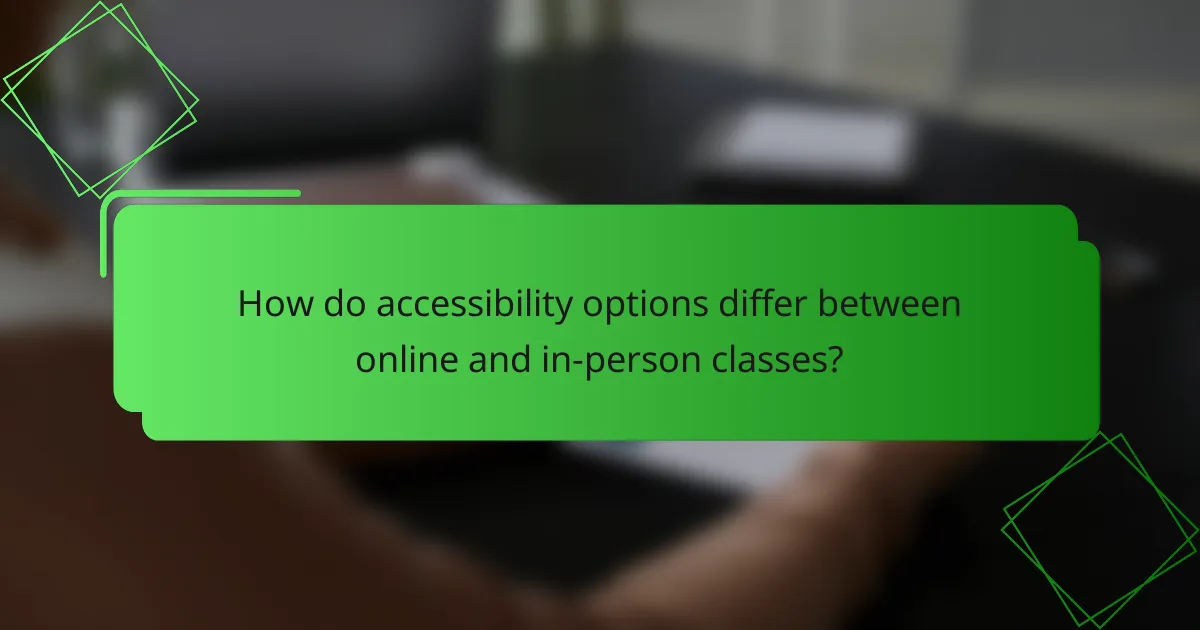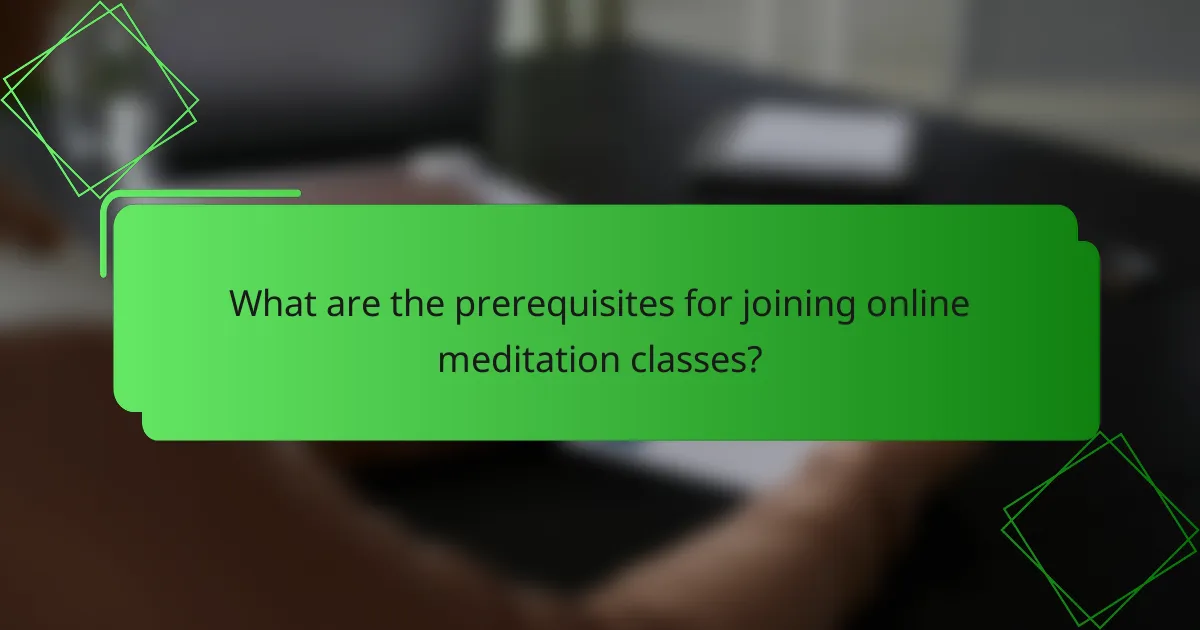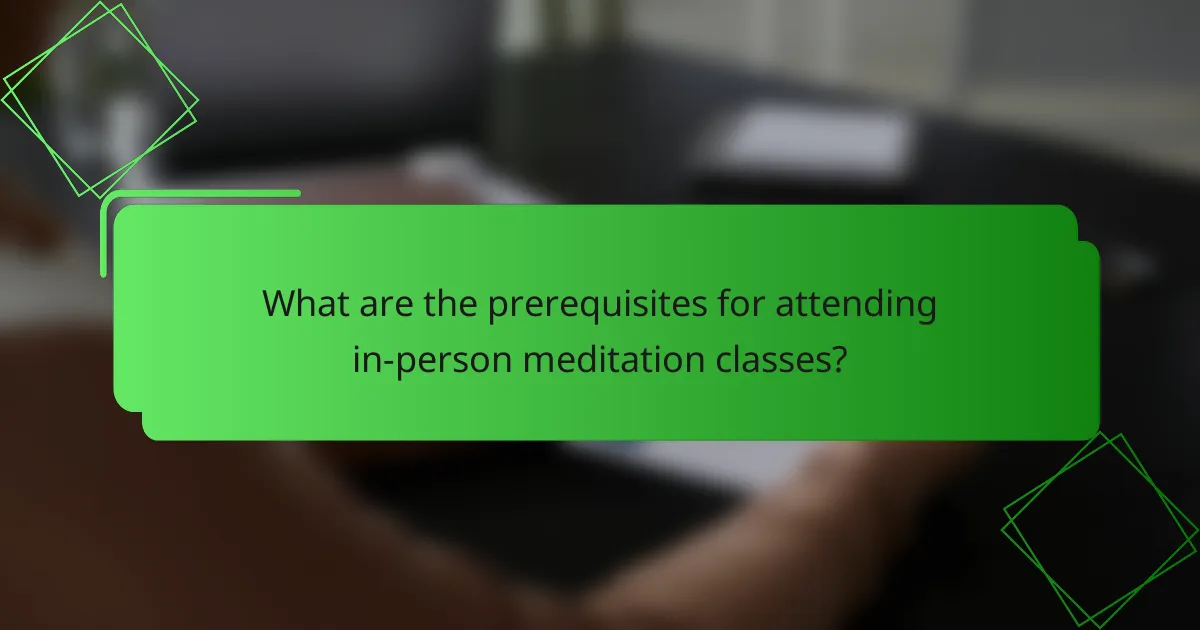The rise of online meditation classes has transformed the accessibility of mindfulness practices, allowing individuals to engage from the comfort of their own homes. While these virtual options provide unparalleled convenience and flexibility, in-person classes offer unique benefits such as personalized guidance and community interaction that can enhance the meditation experience. Understanding the differences in accessibility between these two formats is essential for individuals seeking the most suitable approach to their meditation journey.

What are the benefits of online meditation classes?
Online meditation classes offer convenience and accessibility, allowing individuals to practice mindfulness from anywhere. They cater to various schedules and preferences, making meditation more approachable for many people.
Flexibility in scheduling
One of the main advantages of online meditation classes is the flexibility they provide in scheduling. Participants can choose from a wide range of sessions at different times, accommodating busy lifestyles or varying time zones. This makes it easier to integrate meditation into daily routines.
Many platforms offer recorded sessions, allowing users to meditate at their convenience. This feature is particularly beneficial for those who may not be able to attend live classes due to work or family commitments.
Access to diverse instructors
Online meditation classes connect practitioners with a variety of instructors from around the world. This diversity allows individuals to explore different meditation styles and philosophies, enhancing their practice. Users can find teachers who resonate with their personal beliefs and preferences.
Having access to various instructors also means that practitioners can choose classes that suit their skill levels, whether they are beginners or more advanced meditators. This tailored approach can lead to a more fulfilling meditation experience.
Cost-effectiveness
Online meditation classes are often more cost-effective than in-person options. Many platforms offer subscription models or pay-per-class pricing, which can be significantly lower than the fees for attending physical classes. This affordability makes meditation accessible to a broader audience.
Additionally, some online resources provide free classes or trial periods, allowing individuals to explore different options without financial commitment. This can help users find the right fit before investing in a subscription.
Comfort of home environment
Practicing meditation at home can create a comfortable and personalized environment. Individuals can choose their preferred setting, whether it’s a quiet room, a garden, or even a cozy corner of their living space. This familiarity can enhance relaxation and focus during meditation.
Moreover, being in a home environment eliminates the pressure some may feel in a group setting. This can lead to a more authentic and enjoyable meditation experience, encouraging individuals to engage more deeply with their practice.

What are the benefits of in-person meditation classes?
In-person meditation classes offer several advantages that enhance the overall experience, including personalized guidance, community interaction, and a structured environment. These benefits can significantly improve the effectiveness of meditation practice for individuals seeking deeper engagement.
Personalized guidance
In-person meditation classes provide direct access to instructors who can offer tailored advice based on individual needs. This personalized guidance helps participants refine their techniques and address specific challenges they may face during practice.
For example, an instructor can observe a participant’s posture and breathing and suggest adjustments that enhance comfort and focus. This immediate feedback is often lacking in online formats, where interaction is limited.
Community interaction
Attending meditation classes in person fosters a sense of community among participants. This interaction can create a supportive atmosphere that encourages individuals to share experiences and insights, enhancing their practice.
Being part of a group can also motivate individuals to attend regularly, as they build connections with others who share similar goals. This social aspect can be particularly beneficial for those who may feel isolated in their meditation journey.
Structured environment
In-person classes typically offer a structured environment that can enhance focus and discipline. The physical space is designed to promote relaxation and mindfulness, which can be more challenging to achieve at home.
Many studios provide a calming atmosphere with appropriate lighting, sound, and decor, which can help participants enter a meditative state more easily. Additionally, the scheduled nature of classes encourages commitment and consistency in practice.

How do accessibility options differ between online and in-person classes?
Accessibility options for online and in-person meditation classes vary significantly. Online classes typically offer greater flexibility in terms of location and scheduling, while in-person classes may provide a more immersive experience but can be limited by geographic and physical accessibility constraints.
Geographic limitations
Online meditation classes eliminate geographic barriers, allowing participants from various locations to join without the need for travel. This is especially beneficial for individuals living in remote areas or regions with limited access to wellness facilities.
In-person classes, however, are confined to specific locations, which can restrict participation. For example, someone living in a rural area may have to travel considerable distances to attend a class, potentially incurring travel costs and time commitments that could deter attendance.
Physical accessibility for disabled individuals
Online classes often provide a more accessible option for individuals with disabilities, as they can participate from the comfort of their own homes. This setting allows for easier adjustments to the environment, such as using adaptive equipment or choosing a comfortable space.
In-person meditation classes may face challenges regarding physical accessibility. Not all venues are equipped with ramps, elevators, or accessible restrooms, which can limit participation for individuals with mobility impairments. It’s essential for studios to comply with local regulations, such as the Americans with Disabilities Act (ADA) in the U.S., to ensure inclusivity.

What are the costs associated with online vs. in-person meditation classes?
The costs of online and in-person meditation classes can vary significantly based on several factors. Online classes often have lower upfront costs, while in-person sessions may include additional expenses such as travel and studio fees.
Subscription fees for online platforms
Online meditation platforms typically charge monthly or annual subscription fees, ranging from around $10 to $30 per month. Some platforms offer free trials or tiered pricing based on access to premium content.
When choosing an online service, consider the variety of classes offered, the quality of instructors, and any additional features like community forums or guided sessions. Look for platforms that align with your meditation goals.
Class fees for local studios
In-person meditation classes at local studios usually charge per session, with fees ranging from $15 to $40 per class. Many studios offer package deals or memberships that can reduce the cost per class.
It’s important to factor in travel costs and time when attending in-person classes. Additionally, check if studios provide discounts for first-time visitors or special rates for students and seniors, which can help make classes more affordable.

How do user experiences compare in online and in-person classes?
User experiences in online and in-person meditation classes vary significantly based on accessibility, personal preferences, and community engagement. Online classes often provide flexibility and convenience, while in-person sessions can foster a stronger sense of community and connection.
Feedback from online users
Online meditation classes typically receive positive feedback for their convenience and accessibility. Users appreciate the ability to join sessions from home, which eliminates travel time and costs. Many platforms offer a variety of class times, catering to different schedules.
However, some online participants express concerns about the lack of personal interaction with instructors and fellow meditators. This can lead to feelings of isolation, making it harder for some to stay motivated. Users often suggest incorporating live Q&A sessions or community forums to enhance engagement.
Testimonials from in-person attendees
Attendees of in-person meditation classes frequently highlight the benefits of direct interaction with instructors and peers. Many find that being physically present in a shared space enhances their focus and commitment to the practice. The communal atmosphere often leads to deeper connections and support among participants.
On the downside, in-person classes may require more planning and commitment, as participants need to account for travel and scheduling. Some individuals may also feel intimidated in a group setting, which can affect their overall experience. Balancing these factors is crucial for those considering in-person options.

What are the prerequisites for joining online meditation classes?
To join online meditation classes, you typically need a reliable internet connection, a device capable of streaming video, and a quiet space for practice. Familiarity with basic technology and self-discipline for regular practice are also essential for maximizing the benefits of these classes.
Technology requirements
Participants should have access to a computer, tablet, or smartphone with a webcam and microphone for interactive sessions. A stable internet connection with a speed of at least 5 Mbps is recommended to ensure smooth streaming without interruptions.
Additionally, familiarity with video conferencing platforms like Zoom or Skype is beneficial, as many online meditation classes utilize these tools. It’s advisable to test your setup before the first class to troubleshoot any potential issues.
Self-discipline for home practice
Self-discipline is crucial when attending online meditation classes, as the absence of a physical instructor can lead to distractions. Setting a consistent schedule for practice can help maintain motivation and commitment.
Creating a dedicated meditation space at home can enhance focus and signal to your mind that it’s time to meditate. Consider using reminders or meditation apps to keep you accountable and track your progress.

What are the prerequisites for attending in-person meditation classes?
Attending in-person meditation classes typically requires minimal prerequisites, primarily focusing on an open mind and a willingness to participate. Some classes may have specific age requirements or suggest prior experience with meditation, but many welcome beginners.
Age and Health Considerations
Most meditation classes do not have strict age limits, but participants are often expected to be at least 18 years old. For younger individuals, parental consent may be required. Additionally, individuals with health concerns should consult a healthcare provider before attending, especially if the class involves physical postures or prolonged sitting.
Class Registration and Fees
In-person meditation classes usually require advance registration, which can often be done online or in person. Fees vary widely, ranging from free community sessions to paid classes that may cost anywhere from $10 to $30 per session. Some studios offer package deals for multiple classes, which can provide savings.
What to Bring and Prepare
Participants should bring comfortable clothing suitable for sitting or lying down. A yoga mat, cushion, or blanket may enhance comfort during the session. It’s also helpful to arrive a few minutes early to settle in and prepare mentally for the practice.


